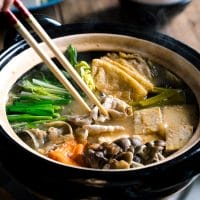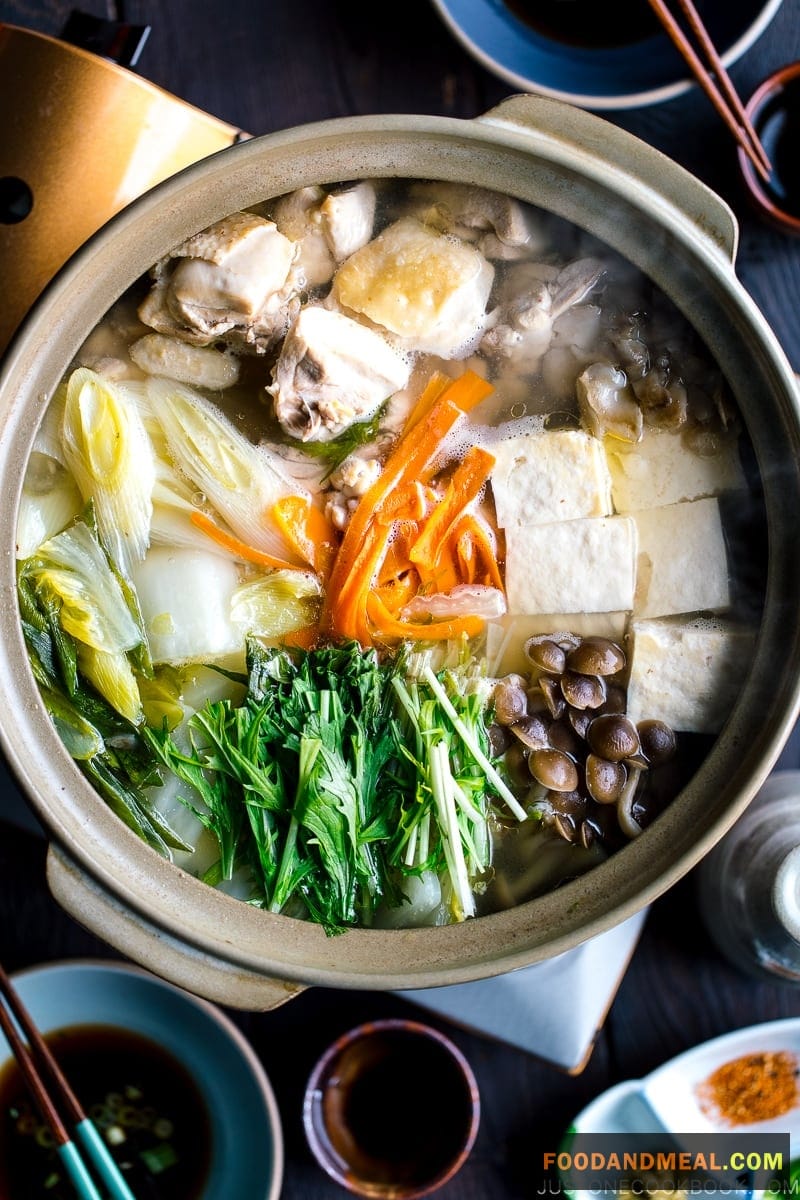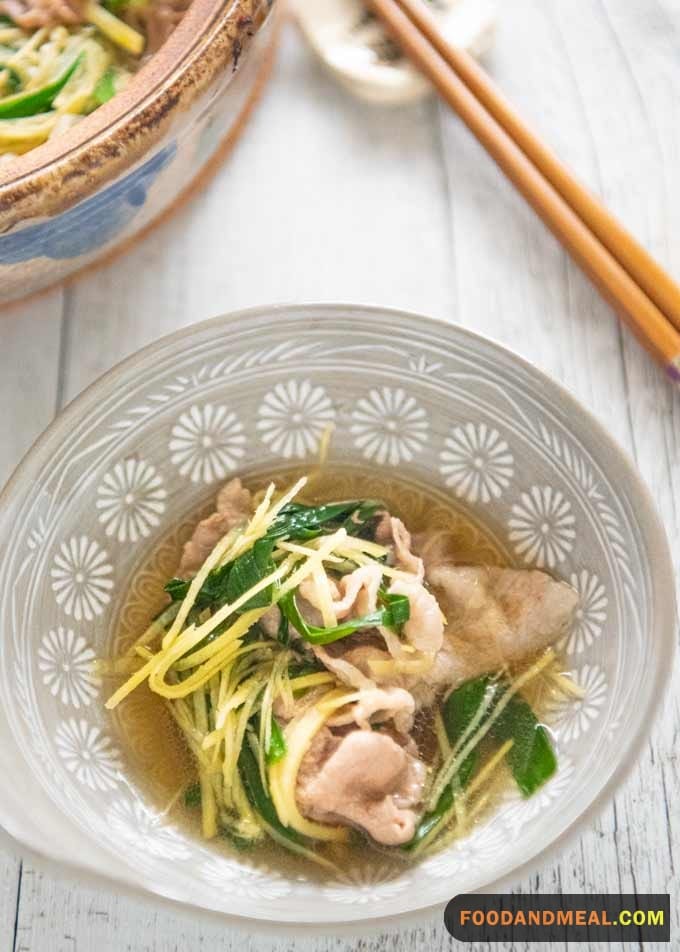As a busy working mom, I’m always looking for quick, healthy meals to feed my family. That’s why I was so excited when I discovered this delicious Ginger Wakame Hot Pot recipe. As soon as the weather turns chilly, I get a craving for heartwarming soups and stews. And having recently fallen in love with Japanese cuisine after a trip to Tokyo last spring, I couldn’t wait to try my hand at this Asian-inspired hot pot.
This soul-soothing soup features two of my favorite ingredients – tangy ginger and mineral-rich seaweed. The combination of flavors is utterly craveable. The ginger adds a delightful zing while the seaweed provides a subtle brininess. And the variety of vegetables makes this a one-pot meal packed with nutrients.
I love that hot pots are so customizable. You can switch up the proteins or veggies depending on what you have on hand or what’s in season. I sometimes add sweet potatoes, bok choy or mushrooms for extra variety. And while this hot pot is perfect for chilly weather, I enjoy it year-round. It’s light enough for spring and summer while still warming and comforting anytime.
The best part is gathering the whole family around the table as the savory broth bubbles away. Hot pots make such fun, interactive meals. Letting everyone customize their bowls with their favorite ingredients. And there are always requests for “just a bit more” broth for sipping once the veggies are gone.

Ginger Wakame Hot Pot Recipe

Japanese Ginger Wakame Hot Pot
Ingredients
For serving:
- white rice, steamed
Instructions
- Combine the soup mixes, 3 cups of cold filtered water and soy sauce in hot pot on med-high.
- Add the ginger, mushrooms, beans and carrots. Bring to a boil. Reduce the heat to low and simmer for five to seven minutes. Veggies should be tender.
- Add spinach and bamboo shoots. Cook for a minute, till spinach wilts. Pour eggs over the mixture.
- Place hot pot of soup on portable burner on dinner table. Provide family or friends with individual bowls and skewers or small strainers.
- Allow diners to add sliced beef to soup mix and cook to their desired level of doneness. Let them serve themselves the soup with a ladle into their bowls. Top them with the bean sprouts and allow them to add rice, if desired.
Video
Notes
Nutrition
© Food And Meal
This website provides approximate nutrition information for convenience and as a courtesy only. Nutrition data is gathered primarily from the Spoonacular Database, whenever available, or otherwise other online calculators.
Alternative Method: Using a Pressure Cooker
Crafting the perfect it begins with rehydrating dried wakame and layering root vegetables in the pressure cooker. Infuse a broth of choice with freshly grated ginger and pour it into the pot with the rehydrated wakame. Cook under high pressure for 15 minutes, followed by a natural release.
Prioritize safety by ensuring complete pressure release before opening. Adjust the seasoning as needed, then serve this aromatic creation garnished with fresh herbs. A culinary journey that balances meticulous preparation with delightful flavors.
Cooking Tips

As I prepare this fragrant this Pot, I can’t help but feel a sense of calm and comfort. There’s something so soothing about simmering broths that fills the kitchen with tempting aromas. And I find chopping the colorful array of vegetables to be an almost meditative practice.
I adore hot pots because they feel deeply nourishing, both for the body and soul. Laden with healthy ingredients like antioxidant-rich wakame seaweed, immune-boosting ginger, and mineral-packed mushrooms and greens. The broth emerges as a tonic – light yet flavorful enough to drink on its own once the vegetables have been devoured.
My favorite part of hot pot preparation is readying the dipping sauces and garnishes that allow everyone to customize their bowls. I set out little dishes of citrusy ponzu sauce, savory sesame oil, chile crisp, and sliced scallions. Offering each component draws out the flavors even more.
I’ve picked up a few tips after making this hot pot several times. Cutting the vegetables small ensures they cook quickly while keeping a nice crunch. Letting the broth come to a gentle simmer extracts the most flavor. And resist overcrowding the pot so everything cooks evenly.
As I ladle this aromatic elixir into bowls, I’m filled with contentment knowing my family will be warmed from the inside out. I hope you’ll also find comfort cooking this pot. May it nourish your family as much as it does mine.
Serving Suggestions

Start by embracing the richness of Seafood Miso Ramen, where the robust flavors of the broth seamlessly harmonize with the aromatic wakame essence, creating a symphony of taste on the palate. Alternatively, immerse yourself in the comforting warmth of Seafood Shio Ramen, offering a perfect balance to the intricate flavors of the hot pot.
For those seeking a unique culinary adventure, the Japanese Aburasoba presents an intriguing twist, with its delectable combination of noodles and flavorful broth. The communal spirit comes alive with the heartiness of Yosenabe Hot Pot, fostering a shared dining experience that beautifully complements the centerpiece of the Hot Pot.
Delight the senses further with the savory goodness of Vegetarian Gyoza, offering a delightful contrast in both texture and taste. Alternatively, bring a touch of freshness to the table with Vegetable Maki Rolls, where the vibrant medley of vegetables seamlessly complements the richness of the hot pot.
FAQs
- Is it essential to use fresh ginger? While fresh ginger offers a bright and more pronounced flavor, ground ginger can be used as a substitute in a pinch. However, the flavor profile might slightly differ. A general rule is 1/4 teaspoon of ground ginger for every tablespoon of fresh ginger.
- Can I use frozen wakame instead of dried? Absolutely! Frozen wakame can be a convenient alternative. Simply thaw it, and you can skip the rehydration step entirely. The flavor and texture will remain quite consistent.
- What other proteins can I add to the hot pot? The beauty of the Ginger Wakame Hot Pot is its adaptability. While the traditional recipe doesn’t always incorporate meat, feel free to add thinly sliced chicken, beef, or even tofu for a vegetarian twist.
- The flavor seems too mild. How can I intensify it? Consider adding a splash more of soy sauce or a sprinkle of bonito flakes. Remember, it’s easier to add more seasoning gradually than to correct an overly salty pot.
- How should I store the leftover hot pot? Once cooled, transfer the hot pot to an airtight container and refrigerate. It’s best consumed within 2-3 days. When reheating, do so over low-medium heat to maintain the dish’s integrity.
Conclusion
In conclusion, this Ginger Wakame Hot Pot is the ultimate comforting, customizable soup for chilly nights. As staff from Food and Meal mentioned, it comes together quickly but tastes like you fussed all day. Packed with immune-boosting ginger, seaweed, and an array of vegetables, it nourishes body and soul. Kids love customizing their bowls with their favorite add-ins like tofu, mushrooms or soba noodles. And the light, gingery broth is so craveable, you’ll want to sip every last drop. This Asian-inspired soup is healthy, heartwarming and fun for the whole family to gather around. I hope you’ll give this delicious hot pot recipe a try soon. It’s sure to become a favorite meal for making memories on cozy evenings at home.
Hi! I'm Nazia of ‘Nazia Cooks’, a self-taught baker and cook residing in Chennai. Rooted in the rich South Indian culinary landscape, my palate has expanded to embrace global flavors. I revel in crafting fusion dishes, melding traditions to birth unique tastes.



